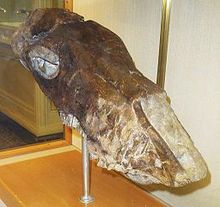Equus namadicus
In today's article we are going to delve into the fascinating world of Equus namadicus. Whatever your interest in this topic, whether for personal or professional reasons, in this article you will find relevant and updated information about Equus namadicus. From its origin to its impact on today's society, through its different aspects and applications, you will immerse yourself in a detailed analysis that will help you understand in greater depth everything related to Equus namadicus. It doesn't matter if you are an expert in the field or if you are just starting to become interested in it, this article is designed to give you a complete and enriching overview of Equus namadicus. Get ready to expand your knowledge and discover new perspectives on this exciting topic!
| Equus namadicus Temporal range: Pleistocene
| |
|---|---|

| |
| Fossil | |
| Scientific classification | |
| Domain: | Eukaryota |
| Kingdom: | Animalia |
| Phylum: | Chordata |
| Class: | Mammalia |
| Order: | Perissodactyla |
| Family: | Equidae |
| Genus: | Equus |
| Species: | †E. namadicus
|
| Binomial name | |
| †Equus namadicus Falconer and Cautley, 1849
| |
Equus namadicus is a prehistoric equid, known from remains dating to the Middle and Late Pleistocene from across the Indian subcontinent, with its last dated records being approximately 29-14,000 years ago. It is considered a "stenonine horse", meaning that it is probably more closely related to zebras and asses than true horses. It is relatively large in size. It is very similar to the earlier Equus sivalensis, also from the Indian subcontinent, from which it only differs in size and in subtle aspects of dental anatomy, and it has sometimes been suggested to be a synonym of it.
References
- ^ Jukar, A. M.; Lyons, S. K.; Wagner, P. J.; Uhen, M. D. (2021-01-15). "Late Quaternary extinctions in the Indian Subcontinent". Palaeogeography, Palaeoclimatology, Palaeoecology. 562: 110137. Bibcode:2021PPP...56210137J. doi:10.1016/j.palaeo.2020.110137. ISSN 0031-0182. S2CID 228877664.
- ^ Cirilli, Omar; Machado, Helena; Arroyo-Cabrales, Joaquin; Barrón-Ortiz, Christina I.; Davis, Edward; Jass, Christopher N.; Jukar, Advait M.; Landry, Zoe; Marín-Leyva, Alejandro H.; Pandolfi, Luca; Pushkina, Diana; Rook, Lorenzo; Saarinen, Juha; Scott, Eric; Semprebon, Gina (September 2022). "Evolution of the Family Equidae, Subfamily Equinae, in North, Central and South America, Eurasia and Africa during the Plio-Pleistocene". Biology. 11 (9): 1258. doi:10.3390/biology11091258. ISSN 2079-7737. PMC 9495906. PMID 36138737.
- ^ Azzaroli, A. (1990), Lindsay, Everett H.; Fahlbusch, Volker; Mein, Pierre (eds.), "The Genus Equus in Europe", European Neogene Mammal Chronology, Boston, MA: Springer US, pp. 339–356, doi:10.1007/978-1-4899-2513-8_20, ISBN 978-1-4899-2515-2, retrieved 2022-06-28
- ^ Sun, Boyang; Liu, Wenhui; Liu, Jinyuan; Liu, Li; Jin, Changzhu (July 2021). "Equus qingyangensis in Jinyuan Cave and its palaeozoographic significance". Quaternary International. 591: 35–46. Bibcode:2021QuInt.591...35S. doi:10.1016/j.quaint.2020.10.076. S2CID 228830965.
- B.J. MacFadden, Fossil Horses, 1992
- J. Curke, A Roman Frontier Post and its People, The Fort of Newstead in the Parish of Melrose, Glasgow 1911 (appendix on animal remains )